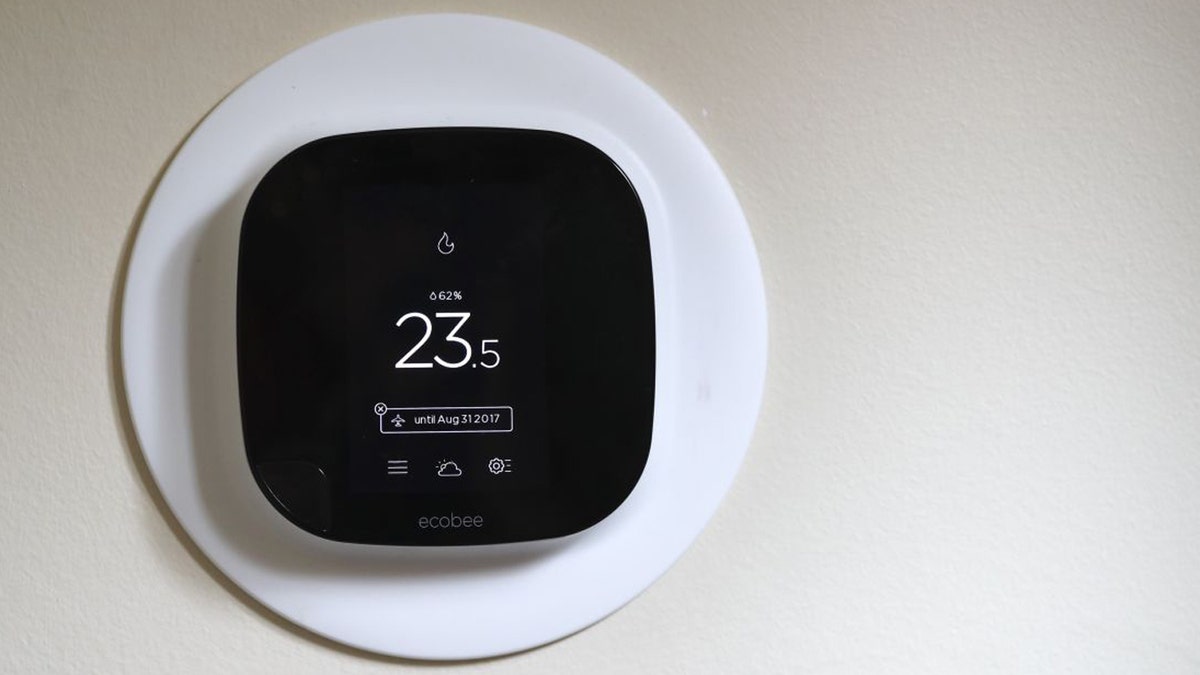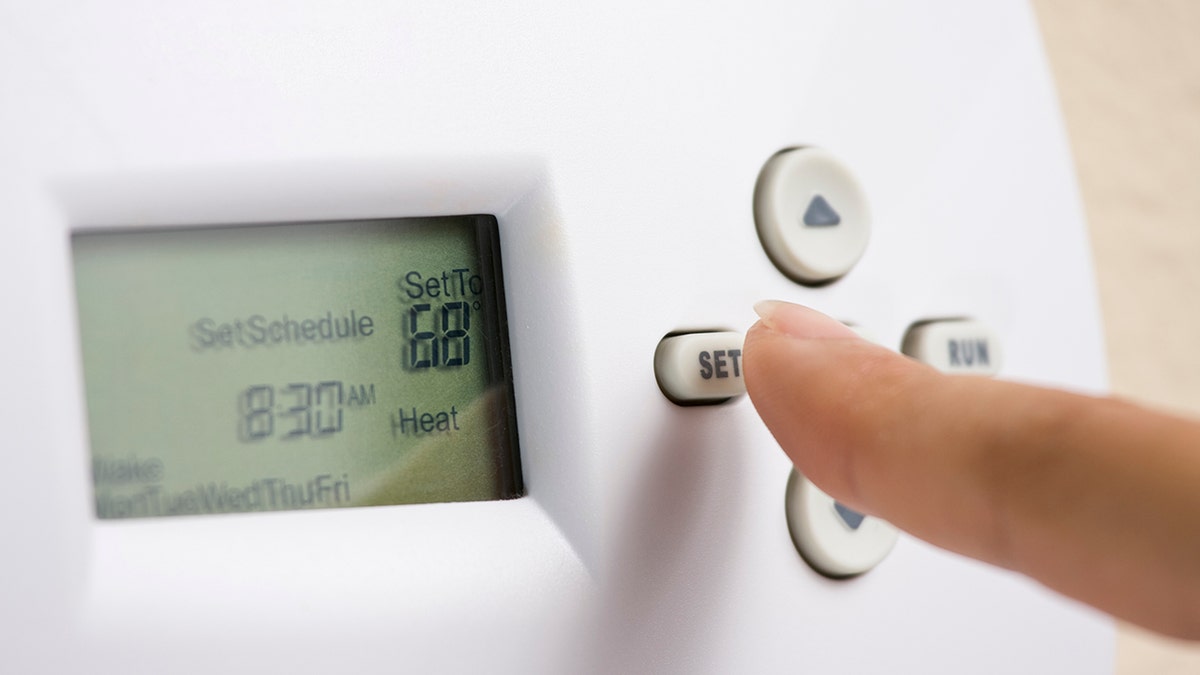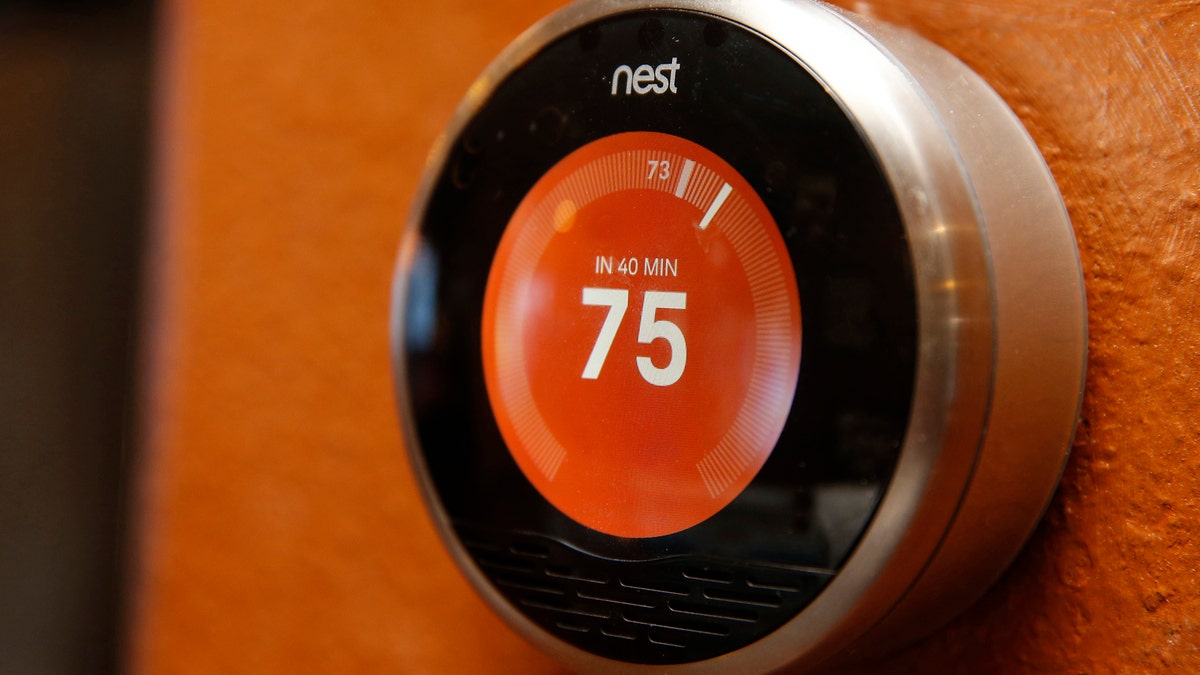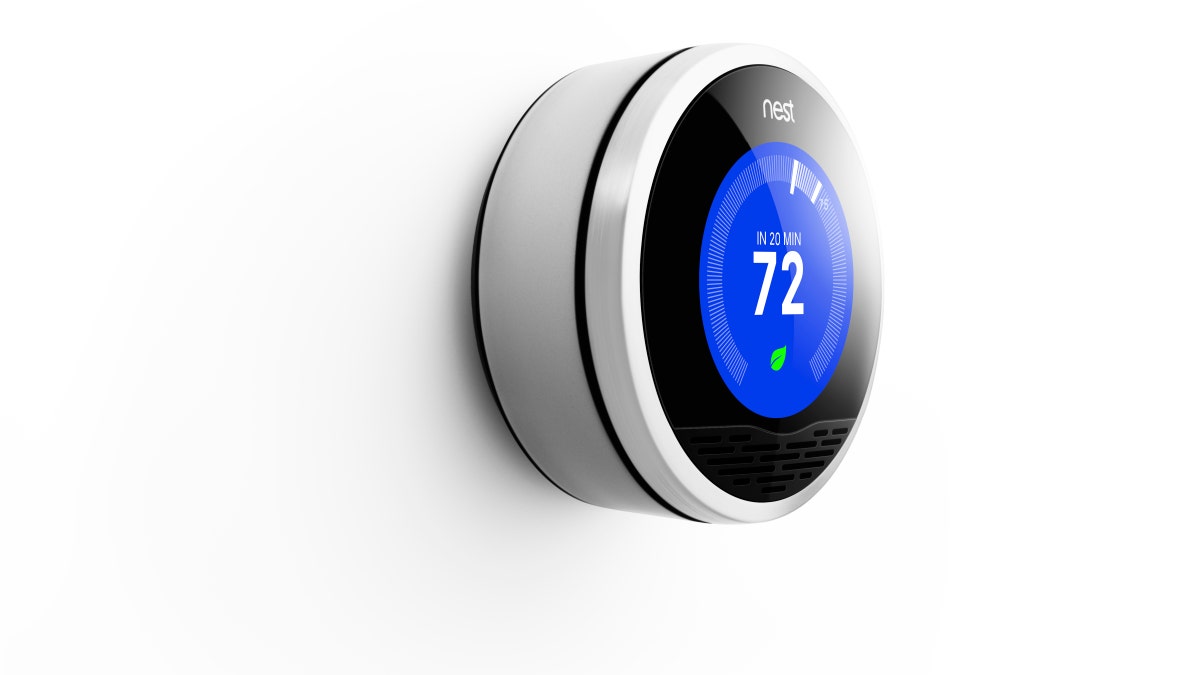Smart thermostats will keep you at the perfect temperature
Energy costs are rising across the country, but smart thermostats may be useful in managing your energy output and budget. Kurt "The CyberGuy" Knutsson reports.
You’ve heard of smartphones, smart light bulbs, and even smart air conditioners, but what about a smart thermostat?
It’s hard not to blast the cold air in the summer or heat in the winter, but with fuel costs rising it is paramount to find ways to manage your energy output. That’s where having a smart or Wi-Fi thermostat can come in handy.
WHO HAS CASH TO BURN FOR THESE EXTRAVAGANT $1,000+ AMAZON GIFTS?

A Honeywell smart thermostat is seen above. (Fox News/Honeywell)
Smart vs. Wi-Fi thermostat
While all smart thermostats are Wi-Fi thermostats, not all Wi-Fi thermostats are smart! Both smart and Wi-Fi thermostats connect to the internet to perform their functions.
Smart thermostats, however, are a step above a just Wi-Fi enabled thermostats because they can 'learn' your behavioral habits and adjust temperature settings accordingly without you having to constantly check or manually adjust it. Whereas, a Wi-Fi thermostat that isn’t "smart" will only adjust based on your prompts or settings.
A common struggle is forgetting to turn off your heating or cooling system when leaving for work or travel. No one likes returning to a freezing or scalding hot home only to realize that they've been flushing their money down the drain. With a smart thermostat, these scenarios are issues of the past because it recognizes when you or your family are home and automatically adjusts the temperature for cooling or heating is optimal for energy savings. Additionally, because it is so "smart" it will preheat or pre-cool your home in anticipation of your arrival, so you don't risk having frozen pipes or a "sauna" upon your return.
WAVE OF GRINCH PORCH PIRATES TRYING TO RUIN CHRISTMAS

Amazon joined a $61 million funding round into smart thermostat maker ecobee Inc. last March. (Getty Images)
Will a Smart or Wi-Fi thermostat put me at risk?
Recently I got a question sent online at CyberGuy.com:
"I’d like to see an article about Wi-Fi thermostats. We are having issues with the furnace system we had installed a year and a half ago and we’ve had the dealer in four times in the last week. I’ve been trying to do research and we are at wits end and wonder can hackers cause issues through a Wi-Fi thermostat. I read hackers broke into a casino’s system through their thermostat. - Sharon F."
As with any device that connects to the internet, there is an inherent risk of being vulnerable to hackers. At most, however, the hackers will likely only be able to access what the thermostat is "privy" to, which would be temperature preferences and the behavioral patterns (arrivals and departures) of those living where the thermostat is operating.
For a thief looking to rob your home, the general whereabouts of its owners might prove useful. But to hackers looking to exploit data, the likelihood of accessing private information is highly unlikely. It does bear repeating that practicing good security hygiene is still worth it.
Making sure to use strong passwords to secure your thermostat and the network it is on will help reduce your risk of falling prey to opportunist hackers looking for a loophole into your home.
SAVINGS TIPS ON THE HOTTEST GIFTS THIS HOLIDAY SEASON

Female hand setting thermostat to 68 degrees Fahrenheit to save energy in the winter. (Fox News)
Smart Thermostats
Benefits of a Smart Thermostat
- Take the guesswork around controlling temperature to maximize comfort, environmental efficiency, and cost
- Cost savings can be 10-23% off utility bills; some utility companies have rebates when you buy smart thermostats
- Adaptability - not only does it do the work for you, but it learns as it goes, so it is continuously optimizing the cooling and heating of your home
- So smart that it knows to apply temperature settings when you’re not home without you having to change the programming - it will know you are not home or asleep
- Works fluidly with smart home network systems such as Google Assistant or Amazon’s Alexa
- Can be set up to send you alerts for maintenance on HVAC systems, which can save you from breakdowns or additional costs in the future.
Cons of a Smart Thermostat
- More expensive than a normal digital thermostat, which can be as low as $25 (comparatively, Smart Thermostats start at around $100)
- Not all Smart Thermostats are compatible with your current HVAC system
- May require additional help with installation from a professional.
TOP TOYS FOR KIDS THIS CHRISTMAS INCLUDE SOME 'MAGIC' AND A SURPRISE PLUSH TOY

A Nest thermostat is installed in a home in Provo, Utah, Jan. 15, 2014. Google took its biggest step to go deeper into consumers' homes, announcing a $3.2 billion deal Jan. 13, 2014, to buy smart thermostat and smoke alarm-maker Nest Labs Inc, scooping up a promising line of products and a prized design team led by the "godfather" of the iPod. (REUTERS/George Frey)
Wi-Fi Thermostats
Benefits of a Wi-Fi thermostat (that isn’t "Smart"):
- Alerts you when your home changes in temperature range, so you can decide whether to raise or lower the temperature
- Unless you're able to set up reminders or alerts, if you forget to turn off the system or have temperature parameters set, it will continue to run until you turn it off (manually or remotely)
- Set the thermostat to raise or drop the temperature when it hits a certain degree
- Saves you money by adjusting temperature vs. keeping the system running all day or night
- Usually able to control settings remotely through your smart home integrated system or mobile app for the thermostat.
Cons of a Wi-Fi thermostat
- More expensive than a normal digital thermostat, which can be as low as $25 (comparatively, Wi-Fi Thermostats start at around $50-60)
- Needs you to make decisions to make changes in temperatures, and it can’t sense the changes of your home (whether people are home or not, etc.) to make adjustments
GIVING TUESDAY: BLANKETS OF HOPE HELPS KEEP THE HOMELESS WARM IN 'MASSIVE MOVEMENT OF KINDNESS'

The Nest smart learning thermostat adopts to its user's lifestyle as well as weather conditions. Will the company's next product be a smoke detector? (©DE)
Top Smart Thermostats + 1 Wi-Fi Thermostat
As technology has become fine-tuned and more sophisticated, there are many options in the market. To narrow it down as well as give you some options to compare, below are my top smart thermostats as well as one Wi-Fi thermostat.
Amazon Smart Thermostat
Pros:
- Depending on your area, it comes with a rebate from your local energy provider via email
- Not expensive as most smart thermostats usually start at the $100 range
- An ENERGY STAR certified thermostat - estimated by the EPA that thermostats with this designation tend to save users an average of $50/year on energy bills
- Created to "seamlessly" integrate with Alexa
- Made with Honeywell Home Thermostat Technology, which is a well-known brand in thermostat technology
- Simple digital display (3 buttons on device: Temperature up, Temperature down, and Select/Mode).
Cons:
- Doesn’t have a speaker or microphone to utilize voice control, so you’d have to use an Alexa-enabled device like an Echo, which you’d have to purchase separately, or the Alexa App
- Not compatible with all HVAC systems
- If your home system requires a c-wire or power adapter kit, the thermostat with that adapter is approximately $24 more expensive
- Only connects to 2.4 GHz 802.11b/g/n and does not support 5GHz
- Does require installation with a power drill and level as well as potential wiring.
ecobee Smart Thermostat
Pros:
- More number of controllers it is compatible with: Apple HomeKit, Google Assistant, Amazon Alexa, IOS, Android
- About the mid-price range for Smart thermostats, approximately $159 at the time of reporting
- Boasts a savings of 26% per year on heating or cooling energy costs
- ENERGY STAR certified
- Automatically heats or cools your home, so you are never heating or cooling an empty home
- Easy installation - most of their customers are able to install in 45 minutes or less
- Compatible with a wider range of systems: most 24VAC HVAC equipment, including conventional furnaces and air conditioners (2H/2C), heat pumps (2H/2C + 1 stage AUX heat), boilers, and PTACs or fan coil units with up to 3 fan speeds
- Includes power extender kits (for systems without a c-wire)
- Made to last 10 years and backed with a warranty for 3 years.
Cons:
- Smart sensors are sold separately, but it allows you to control the temperature of specific rooms.
Honeywell Home T9
Pros:
- ENERGY STAR CERTIFIED
- Connects to both 2.4 & 5 GHz Wi-Fi connections
- Simple, digital display for ease of use
- Works with App, touch or voice control
- In addition to indoor and outdoor temperature control, it does sense humidity levels as well
- About the mid-price range for Smart thermostats, approximately $158 at the time of reporting.
Cons:
- Does not work with heating-only oil furnace systems unless a C-Wire is present, which needs to be purchased separately.
Google Nest Learning Thermostat
Pros:
- Compatible with 95% of cooling & heating systems
- Most people can install the thermostat in 30 minutes or less
- Can be controlled by remote, app, or voice
- Connects through Bluetooth and Wi-Fi
- ENERGY STAR certified
- According to independent studies, Nest thermostats saved people approximately 10-12% on heating and 15% on cooling energy costs.
Cons:
- Expensive - starting at $200 & up.
EMERSON Sensi Touch
Unlike the other thermostats listed in this article, this is a Wi-Fi thermostat, not a smart thermostat. While you can add parameters such as temperature lows and highs that cue the thermostat to turn on or off, it does not learn the behavioral habits of its user to adjust intuitively. You have to manually adjust settings in order to gain energy cost benefits.
Pros:
- Large, clear digital display with menus easily accessible on thermostat
- Additional privacy protection as Sensi will not sell your data to third parties
- Works with most HVAC systems, but requires c-wire, which is sold separately
- ENERGY STAR-certified and boasts energy savings of 23%
- Compatible with Amazon Alexa, Apple HomeKit, Google Assistant and Samsung SmartThings
- Can be controlled remotely with the Sensi Mobile App available.
Cons:
- Expensive as it starts at $165, which is the price point for smart thermostats boasting better features
- Requires 2.4 Ghz Wi-Fi connection
- Most systems require a c-wire for setup, which is sold separately.
CLICK HERE TO GET THE FOX NEWS APP
With energy costs fluctuating and the winter months taking full effect, will you invest in a smart or Wi-Fi thermostat? Already have one? Share any positive or negative experiences you've had as well as any cost-savings you gleaned!
Copyright 2022 CyberGuy.com. All rights reserved. CyberGuy.com articles and content may contain affiliate links that earn a commission when purchases are made.





















